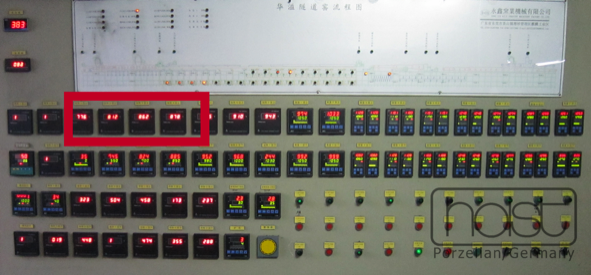Gas phase

"... Door closed, porcelain in, temperature high and after a while door open again, porcelain is ready..." This is how many consumer imagine the firing process of porcelain or ceramic tableware.
Unfortunately it ain't that simple!
Porcelain firing is a philosophy in itself and is built on years of very dearly bought experience. Every single mistake means breakage, shards or unsaleable goods in the end. There is no technical book, no manual and no recipe for firing.
The ceramic body ready for firing consists of the mass (greenbody or body), of a glaze and a variety of mineral raw materials from all over the world like
- China (kaolin & clays)
- India (clays et al)
- New Zealand (aluminas, zirconia et al)
- Thailand (feldspar et al)
- Germany (alumina, kaolin et al)
- France (quartz, glazes et al)
- Australia (alumina)
- a.o.
The gas phase cleans the porcelain masses
Each of these raw materials, even if it comes from the same source, always differs from each other. They are just natural raw materials! Such earthen raw materials contain undesirable proportions of organic adhesions, silicates, oxides, embedded hydrogen and carbon particles, etc. The porcelain firing removes moisture from the firing body and makes it thermally compressed by shrinkage.
In sum and summary, a considerable amount of gases is formed in this thermal compression process, which must be burned out of the ceramic body without residues thereof contaminating any of the subsequent firing stages (firing processes). The Porceliner refers to this firing stage as "the purification phase".
In this firing phase the glaze must not yet be closed and must allow the gases that burn out to espace unhindered. By the way, this also includes the so-called deacidification process of any carbonates that may have been introduced.
The professional griller can compare this gas phase with the time period when the barbecue charcoal matures to the actual embers and the gases of benzene, ethanol and other additives are burned out. If this annealing phase is bypassed, the grilled food would not only absorb the unpleasant taste, but also the pollutants. It is about the same with the gas phase of the porcelain.
In order for a ceramic raw body to burn out sufficiently, it requires an appropriate temperature and time! Time is an important and also cost-intensive "raw material" in porcelain production, because it occupies space and capacities.
Such a degassing phase (cleaning phase) must be carried out for all types of ceramic ware and firing, whether in a tunnel kiln, block kiln, fast firing kiln, single firing or double firing.
The best gas phase application
Which of these possibilities represents "the best form of degassing" for the porcelain is controversially discussed among honest porcelain makers. For the manufacturer's wallet, the monofiring in the fast-firing kiln is clear, as some manufacturers of English Vitreous China probably honestly sell it as a 40% cost saving. Why then, however, this product is not offered at a significantly lower price, we do not understand.
The very small group of remaining German production sites still prefers the dual brand. One of them justifies this, among other things, as the implementation of customer needs identified with "seismographic precision." Others have a decrepit kiln financed with KWG funds, state and national subsidies as an eco, ecological or energy-saving measure and adorn themselves with the new fast-firing technology with the blue environmental seal.
At Holst Porcelain, we believe that the raw material time cannot be subjected to a maturing process indefinitely. Compression of time occurs in fast firing by, among other things, increasing the physical elements of energy and pressure. Therefore, we believe that a conventional firing time is more conducive to the purity of the porcelain than a compressed fast firing.
